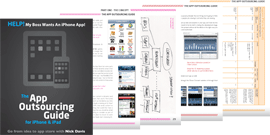As well as any third-party stats and analytics tracking that may have been set-up in your app (which you should now be able to access), you should also now have access to some information about your app from Apple (including the number of downloads so far).
There are two ways to access the data from Apple. I find the second option the easiest to use but I will take you through both:
#1 iTunes Connect website
The main way of accessing your data but, although Apple has improved it, I still don’t find it as easy as it should be to get an overall picture. Nevertheless, if you want to check-in daily or weekly on the number of downloads of your app, it will give you this key information.
To access this, simply login in to the iTunes Connect website with your Apple Developer ID and password and click ‘Sales and Trends’. From there you have two views of the data. The default is Breakdown and in this view you will be given a choice of:
- Daily / Weekly Shows a daily/weekly download count of all apps for that Developer account. You can view the past 14 days or past 13 weeks breakdown from any particular date (but going back no further than 26 weeks from today).
- Free Apps / Paid Apps / In Apps / Updates Breaks down the graph into these categories only. Updates refers to the number of updated apps downloaded in that period.
- Top Apps / Top Markets Shows the number of apps split by product (if you have more than one app) and App Store (country) for the past day or week.
The second view is Sales. This is more of a ‘data’ view. Again you can filter by day or week as long as it is within the last 26 weeks. You can also download the data which then can then be imported into a spreadsheet program (such as Microsoft Excel) via a .csv file.
For further information on ‘Sales and Trends’ take a look at Apple’s ‘App Store Reporting Guide’
apple.com/itunesnews/docs/AppStoreReportingInstructions.pdf
#2 iTC mobile app
Apple also have an app version of the ‘Sales and Trends’ data (with some slight differences). You can’t hide find this app by searching in the App Store though, you have to download it through the following link: http://itunes.apple.com/us/app/itunes-connect-mobile/id376771144?mt=8
Once you’ve installed the app to your iPhone or iPad, simply start it up, enter your Apple Developer ID and password and you’re off and running. The screens are fairly straightforward and, as with the previous version, you can view data up to 26 weeks old.
The main thing I like about this version is, if you have multiple apps, you can choose the ‘Products’ navigation option and easily see a breakdown of the total number of downloads for each app during the selected time period. I find this easier to use for a quick check then, than the iTunes Connect version which, by default, blends them all into a single figure. You can also view data by Markets (App Store / country) as well as viewing the total number of Updates if you wish.
Remember if you want to download any stats for your records though you will need to login to the iTunes Connect website as you cannot download any stats through the app. If you’re interested in preserving this information for auditing or any other reason, make sure you remember to download these fairly regularly as Apple only lets you download data from the previous 26 weeks.
For further information on the iTC Mobile App take a look at Apple’s ‘iTunes Connect Mobile User Guide’
apple.com/itunesnews/docs/iTC_Mobile_UserGuide.pdf
